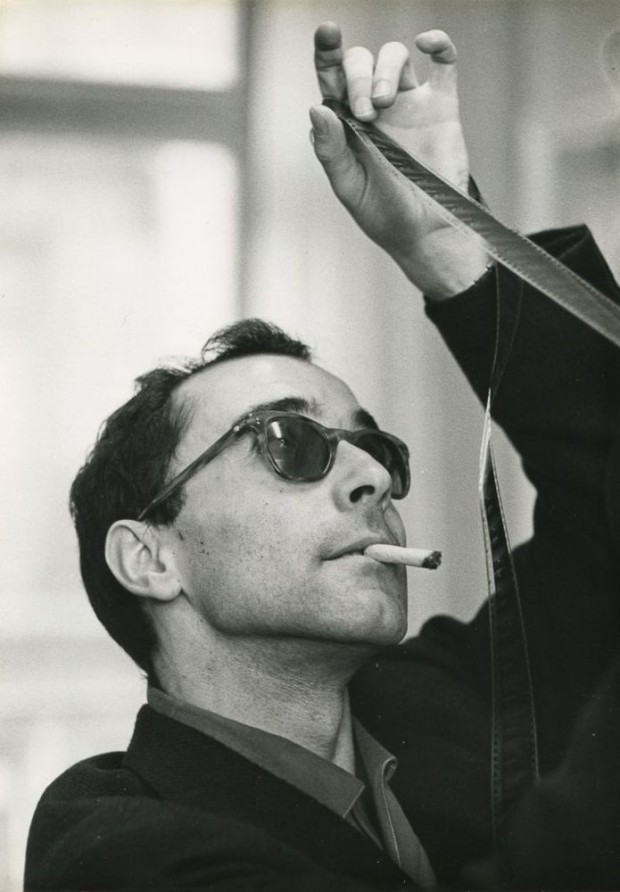An iconographic and text archive related to communication, technology and art.
☛ artnet: Jean-Luc Godard photographed by Philippe R. Doumic, circa 1960. Gelatin silver print, 18 x 13 cm. (7.1 x 5.1 in.). Large format retrieved from falter.at. © Unifrance Films.
The photo was likely taken during or just after the production of À bout de souffle, which was released in France on March 17, 1960. Another portrait taken by Philippe R. Doumic during the same photo session shows Godard (same jacket, same shirt, same glasses) as he talks over the phone. In the background, the poster of À bout de souffle is clearly visible. On yet other photos, Godard is seen working through still photographs from the film.

Various portraits of directors working in editing rooms can be found online. Julien Girardot collected such pictures on one of his Pinterest board (“Chambre de montage”). So has Raffaella Antonutti on her own board (“Film Editing”). The old archive of Cinephilia & Beyond has a couple of them as well (the new site with the corresponding page).
Here, I’m specifically interested in photos depicting directors as they examine strips of celluloid film (nitrate or acetate, before the polyester base was introduced in the 1980s), often in a pose similar to the one adopted by Godard in Doumic’s iconic portrait. Many of those images are well-known, but I wanted to provide them with some contextual information. I left aside images I could not properly identified (except for the last Kurosawa double-portrait). Also excluded are pictures of film directors looking at editing equipments instead of strips of film, or photos of film editors (see for example “The 4 Unsung Pioneers of Film Editing”).
The portraits collected appear in chronological order, starting with this image of Buster Keaton. It’s actually a production still for his movie Sherlock Jr., released in 1924. Keaton plays the main character: a movie theater projectionist who tries to become a detective.

In the portrait shown below, Russian director Sergei Eisenstein is busy editing his film October, which was released on January of 1928. The image is reproduced in Eisenstein’s Notes of a film director (the English translation was published in 1959: see page 81). There’s another photo showing Eisenstein editing a reel of film which I could not properly identified.
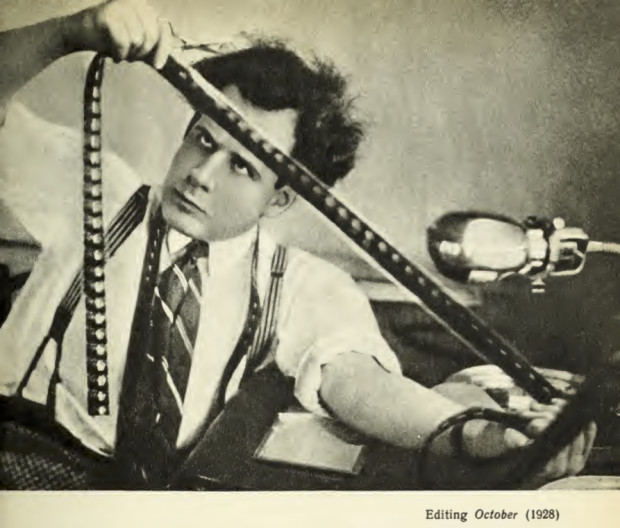
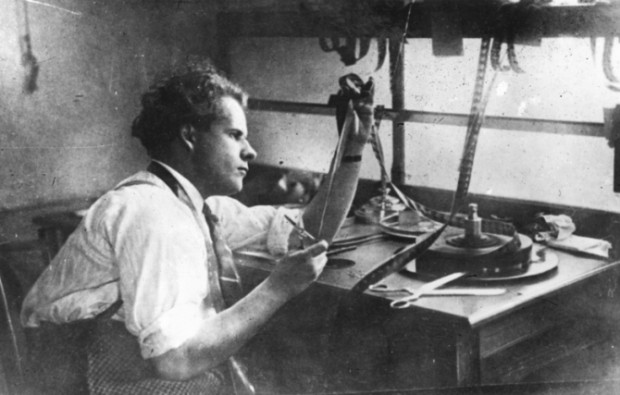
Then comes a photo of Leni Riefenstahl from c. 1935. The image belongs to the Hulton Archive which is being managed by Getty Images (editorial no. 53312785). However, at the time of writing the information provided by Getty on its website is not accurate (the description does not fit the image).

Below is a photo from February 1944 showing Colonel Frank Capra on the right as he examines strips of film from the production of Tunisian Victory. The propaganda film about the North Africa Campaign was released in March of the same year. The photo is part of the collection of the Imperial War Museums and is made available under the terms of the IWM Non Commercial Licence (catalog number D 18377).
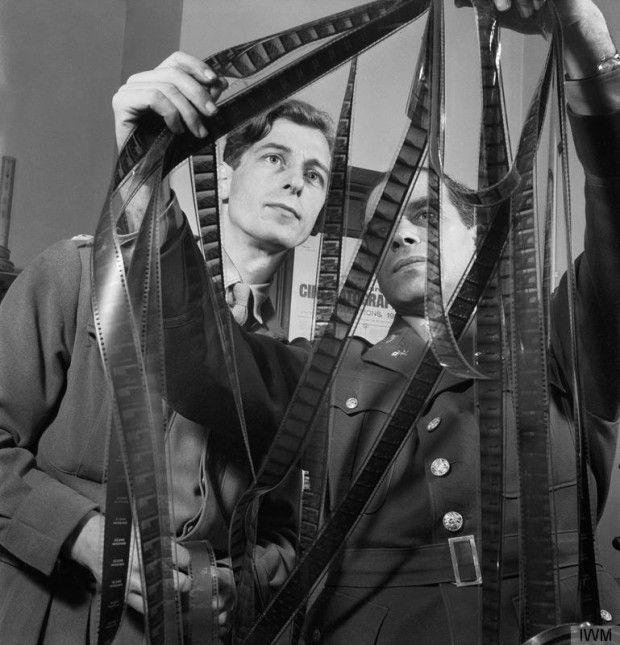
Next is two portraits of US film director Robert Flaherty who is probably best known for his 1922 documentary film Nanook of the North (1922). The first photo was taken in 1948 by Arnold Eagle. It shows Flaherty working with Helen van Dongen on location, in Louisiana, where he was shooting Louisiana Story. The film was released later the same year, in September. The second photo was taken by photographer Haywood Magee on September 10, 1949. It is licensed by Getty Images (editorial no. 3306300).


The following portrait shows Billy Wilder working on a scene of his film Ace in the Hole, which was released in June of 1951. The photograph was taken the same year by LIFE magazine staff photographer Bob Landry. It appears in the issue of February 19, 1951, in a piece explaining the techniques used by Wilder to edit his movies (pp. 57-62). The same image is also licensed by Getty Images (editorial no. 50876384).
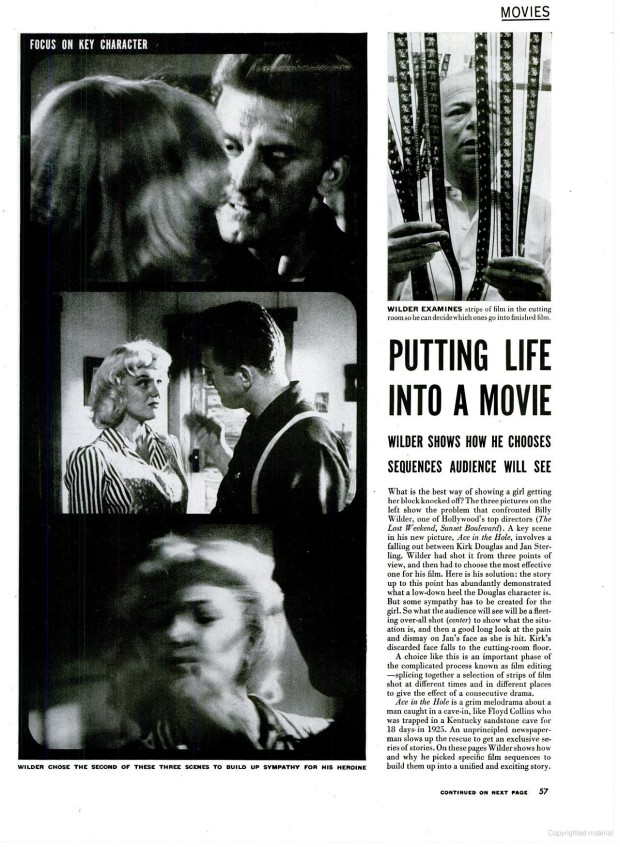
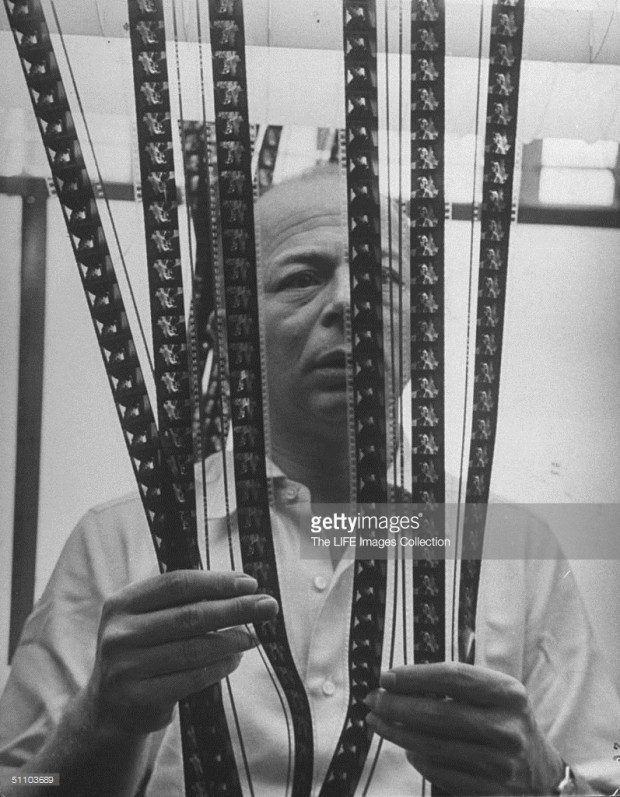
The next image shows American director Elia Kazan as he is editing his controversial film Baby Doll, which was released on December 18, 1956. The photo was used in the issue of LIFE magazine from January 7, 1957 (p. 65), in a piece examining “The bitter dispute” over the film. Also worth mentioning is the name of the photographer: Gordon Parks. Parks worked as a staff photographer and writer for LIFE, but he was also a movie director. In 1971, he directed the classic blaxploitation movie Schaft.


Another famous photo shows Samuel Beckett inspecting a piece of film. The photo was taken on the set of Beckett’s Film, the only movie screenplay he ever wrote. The short film, which was shot in New York in 1964 and released in 1965, was directed by Alan Schneider and starred Buster Keaton. At the time of writing, it is available to watch online at Ubuweb. The photo displayed below was taken by Steve Shapiro who shared the following comments with Siobhan Bohnacker for a short piece published by The New Yorker in 2013:
“Beckett seemed introspective and engrossed in his own world. Most of the time, I doubted that he was even aware I was there, and I am sure cared less. For me, this was ideal …. As introverted and taciturn as he was reputed to be, he was thoroughly engaged in the art of filmmaking. Nothing escaped his eye. He was attentive to every small detail, examined each prop, sometimes even with a magnifying glass. He studied everything. The parrot in the cage and the dog and cat in the basket delighted him. He spent many hours observing their movements.” (“A Reluctant Subject: Portraits of Samuel Beckett” by Siobhan Bohnacker, The New Yorker, December 3, 2013).
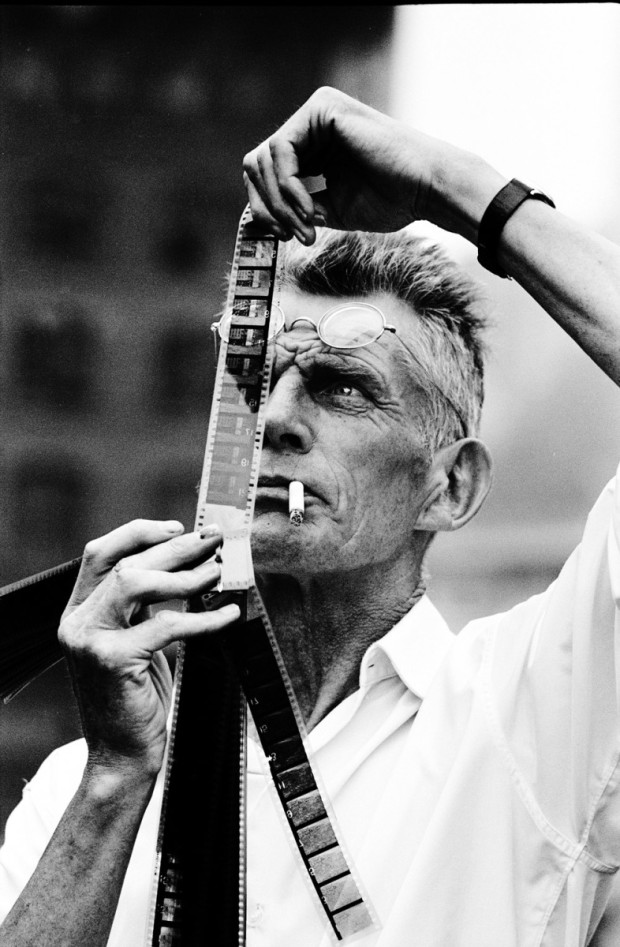
Then is Italian director Michelangelo Antonioni. This image also belongs to the Hulton Archive. The photographer is unknown, but the image is dated from 1965, the year Red Desert (Il deserto rosso) was released in the United-States.

The next image shows director Mike Nichols (right) with film editor Sam O’Steen (left) as they are working in an editing room on the movie Who’s Afraid of Virginia Woolf? The movie was released in June of 1966 to critical acclaimed. It was nominated for thirteen Academy Awards, winning five of them. The photo was taken by Bob Willoughby, himself an acclaimed set photographer.
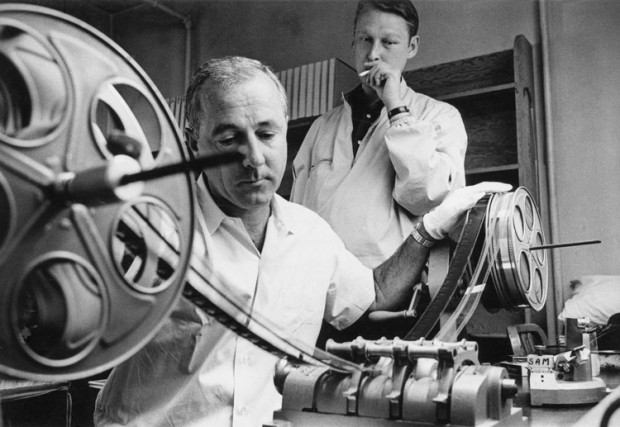
The next portrait is from 1967: it shows Ken Russell examining some strips of film. The image is licensed by Topical Press Agency/Getty Images (editorial no. 2636334). It is possible to speculate that the photo was taken in the context of the production of Billion Dollar Brain which was released the same year. The Guardian has it that the portrait is rather from 1966 and that the director is actually examining film negatives: “Ken Russell: a life in photographs – in pictures” (Nov. 28, 2011).
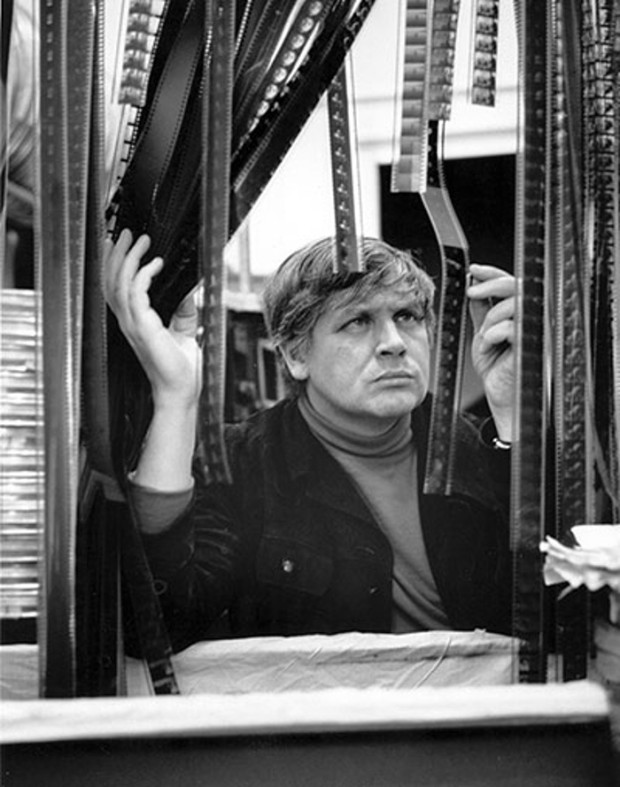
The following portrait shows Woody Allen looking at a reel from his film Love and Death (actually he seems to be looking at a piece of opaque film leader). The film opened on June 10th, 1975. The portrait was taken by Newsweek staff photographer Bernard Gotfryd. Gotfryd, a Holocaust survivor, is a celebrated photographer. His photograph collection is hosted at the New-York Historical Society (read more about it here).

Finally, two photos of Akira Kurosawa which I couldn’t properly identified using the information currently available online. The one on the left is found on numerous online sites, while the one the right is hosted by the BFI.
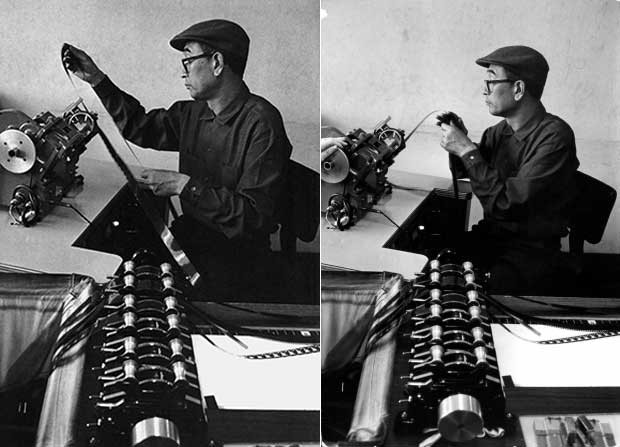
- By Philippe Theophanidis
- on
- ― Published in Art, Movies, Technology
- Tagged: celluloid, editing, film, filmmaker, Godard

